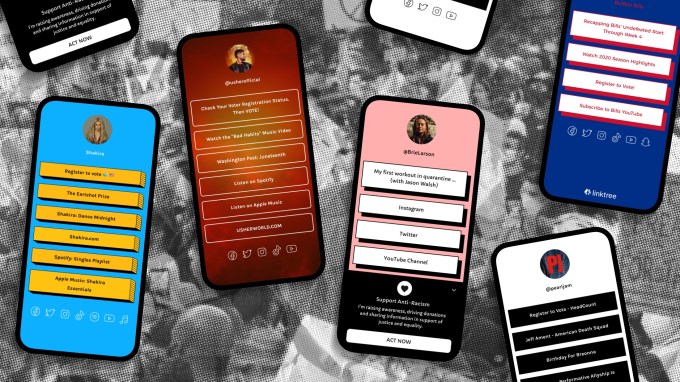Recent Funding
Auto Added by WPeMatico
Auto Added by WPeMatico
Earlier this year, the founders of event analytics platform Hubilo pivoted to become a virtual events platform to survive the impact of COVID-19. Today, the startup announced it has raised a $4.5 million seed round, led by Lightspeed, and says it expects to exceed $10 million bookings run rate and host more than one million attendees over the next few months.
The round also included angel investors Freshworks CEO Girish Mathrubootham; former LinkedIn India CEO Nishant Rao; Slideshare co-founder Jonathan Boutelle; and Helpshift CEO Abinash Tripathy.
Hubilo’s clients have included the United Nations, Roche, Fortune, GITEX, IPI Singapore, Tech In Asia, Infocomm Asia and Clarion Events. The startup is headquartered in San Francisco, but about 12% of its sales are currently from Southeast Asia, and it plans to further scale in the region. It will also focus on markets in the United States, Europe, the Middle East and Africa.
Vaibhav Jain, Hubilo’s founder and CEO, told TechCrunch that many of its customers before the pandemic were enterprises and governments that used its platform to help organize large events. Those were also the first to stop hosting in-person events.
In February, “we knew that most, if not all, physical events were getting postponed or cancelled globally. To counter the drop in demand for offline events, we agreed to extend the contracts by six more months at no cost,” Jain said. “However, this was not enough to retain our clients and most of them either cancelled the contracts or put the contract on hold indefinitely.”
As a result, Hubilo’s revenue dropped to zero in February. With about 30 employees and reserves for only three months, Jain said the company had to choose between shutting down or finding an alternative model. Hubilo’s team created an MVP (minimum viable product) virtual event platform in less than a month and started by convincing a client to use it for free. That first virtual event was hosted in March and “since then, we’ve never looked back,” said Jain.
This means Hubilo is now competing with other virtual event platforms, like Cvent and Hopin (which was used to host TechCrunch Disrupt). Jain said his company differentiates by giving organizers more chances to rebrand their virtual spaces; focusing on sponsorship opportunities that include contests, event feeds and virtual lounges to increase attendee engagement; and providing data analytic features that include integration with Salesforce, Marketo and HubSpot.
With so many events going virtual that “Zoom fatigue” and “webinar fatigue” have now become catchphrases, event organizers have to not only convince people to buy tickets, but also keep them engaged during an event.
Hubilo “gamifies” the experience of attending a virtual event with features like its Leaderboard. This enables organizers to assign points for things like watching a session, visiting a virtual booth or messaging someone. Then they can give prizes to the attendees with the most points. Jain said the Leaderboard is Hubilo’s most used feature.
Powered by WPeMatico
Simple, link-centric user profiles might not sound like a particularly ambitious idea, but it’s been more than big enough for Linktree.
The Melbourne startup says that 8 million users — whether they’re celebrities like Selena Gomez and Dua Lipa or brands like HBO and Red Bull — have created profiles on the platform, with those profiles receiving more than 1 billion visitors in September.
Plus, there are more than 28,000 new users signing up every month.
“This category didn’t exist when we started,” CEO Alex Zaccaria told me. “We created this category.”
Zaccaria said that he and his co-founders Anthony Zaccaria and Nick Humphreys created Linktree to solve a problem they were facing at their digital marketing agency Bolster. Instagram doesn’t allow users to include links in posts — all you get is a single link in your profile, prompting the constant “link in bio” reminder when someone wants to promote something.
Meanwhile, most of Bolster’s clients come from music and entertainment, where a single link can’t support what Zaccaria said is a “quite fragmented” business model. After all, an artist might want to point fans to their latest streaming album, upcoming concert dates, an online store for merchandise and more. A website could do the job in theory, but they can be clunky or slow on mobile, with users probably giving up before they finally reach the desired page.

Linktree founders Anthony Zaccaria, Alex Zaccaria and Nick Humphreys. Image via Linktree.
So instead of constantly swapping out links in Instagram and other social media profiles, a Linktree user includes one evergreen link to their Linktree profile, which they can update as necessary. Selena Gomez, for example, links to her latest songs and videos, but also her Rare Beauty cosmetics brand, her official store and articles about her nonprofit work.
Zaccaria said that after launching the product in 2016, the team quickly discovered that “a lot more people had the same problem,” leading them to fully separate Linktree and Bolster two years ago. Since then, the company hasn’t raised any outside funding — until now, with a $10.7 million Series A led by Insight Partners and AirTree Ventures. (Update: Strategic investors in the round include Twenty Minute VC’s Harry Stebbings, Patreon CTO Sam Yam and Culture Amp CTO Doug English.)
“We had the option to just continue to grow sustainably, but we wanted to pour some fuel on the fire,” Zaccaria said.
In fact, Linktree has already grown from 10 to 50 employees this year. And while the company started out by solving a problem for Instagram users, Zaccaria described it as evolving into a much broader platform that can “unify your entire digital ecosystem” and “democratize digital presence.” He said that while some customers continue to maintain “a giant, brand-immersive website,” for others, Linktree is completely replacing the idea of a standalone website.
Zaccaria added that Instagram only represents a small amount of Linktree’s current traffic, while nearly 25% of that traffic now comes from direct visitors.

Image Credits: Linktree
Black Lives Matter has also been a big part of Linktree’s recent growth, with activists and other users who want to support the movement using their profiles to point visitors to websites where they can donate, learn more and get involved. In fact, Linktree even introduced a Black Lives Matter banner over the summer that anyone could add to their profile.
Linktree is free to use, but you have to pay $6 a month for Pro features like video links, link thumbnails and social media icons.
Zaccaria said that the new funding will allow the startup to add more “functionality and analytics.” He’s particularly eager to grow the data science and analytics team, though he emphasized that Linktree does not collect personally identifiable information or monetize visitor data in any way — he just wants to provide more data to Linktree users.
In a statement, Insight Managing Director Jeff Lieberman said:
As the internet becomes increasingly fragmented, brands, publishers, and influencers need a solution to streamline their content sharing and connect their social media followers to their entire online ecosystem, ultimately increasing brand awareness and revenue. Linktree has successfully created this new “microsite” category enabling companies to monetize the next generation of the internet economy via a single interactive hub. The impressive traction and growing number of customers Linktree has gained over the last few months demonstrates its proven market fit, and we could not be more excited to work with the Linktree team as they transition to the ScaleUp phase of growth.
Powered by WPeMatico
Lunar, the Nordic challenger bank that started out life as a personal finance manager app (PFM) but acquired a full banking license in 2019, has raised €40 million in Series C funding from existing investors.
The injection of capital follows a €20 million Series B disclosed in April this year and comes on the back of Lunar rolling out Pro paid-for subscriptions — similar to a number of other challenger banks in Europe — personal consumer loans, and the launch of business bank accounts in August.
The latter appears to have been an instant success, perhaps proof there is — like in the U.K. — pent up demand for more accessible banking for sole traders. Just months since launching in Denmark, Lunar Business claims to have signed up more than 50% of all newly founded sole trader businesses in the country.
I’m also told that Lunar has seen “best-in-class” user engagement with users spending €1,100 per month versus what the bank says is a €212 EU average for card transactions. Overall, the bank has 5,000 business users and 200,000 private users across Denmark, Sweden and Norway.
Meanwhile — and most noteworthy — after launching its first consumer lending products on its own balance sheet, Lunar has set its sights on the “buy now, pay later” market, therefore theoretically encroaching on $10.65 billion valued Klarna, and Affirm in the U.S., which just filed to go public. Other giants in the BNPL space also include PayPal.
Lunar founder and CEO Ken Villum Klausen says the “schizophrenic” Nordic banking market is the reason why the challenger is launching BNPL. “It’s the most profitable banking landscape in the world, but also the most defensive, with least competition from the outside,” he says. “This means that the traditional banking customer is buying all their financial products from their bank”.
It is within this context that Lunar’s BNPL products are built as “post-purchase,” where Lunar will prompt its users after they have bought something (not dissimilar to Curve’s planned credit offering). For example, if you were to buy a new television, the app will ask if you want to split the purchase into instalments. “This does not require merchant agreements etc, and will work on all transactions both retail and e-commerce,” explains Klausen.
“We do not view Klarna as a direct competitor as they are not in the Nordic clearing system,” he adds. “Hence, you cannot pay your bills, get your salary and use it for daily banking. Klarna is enormous in Sweden, but relatively small in Denmark, Norway and Finland”.
In total, Lunar has raised €104 million from investors including Seed Capital, Greyhound Capital, Socii Capital and Chr. Augustinus Fabrikker. The challenger has offices in Aarhus, Copenhagen, Stockholm and Oslo, with a headcount of more than 180 employees. It plans to launch its banking app in Finland in the first half of 2021.
Powered by WPeMatico
Render, the winner of our Disrupt SF 2019 Startup Battlefield, today announced that it has added another $4.5 million onto its existing seed funding round, bringing total investment into the company to $6.75 million.
The round was led by General Catalyst, with participation from previous investors South Park Commons Fund and a group of angels that includes Lee Fixel, Elad Gil and GitHub CTO (and former VP of Engineering at Heroku) Jason Warner.
The company, which describes itself as a “Zero DevOps alternative to AWS, Azure and Google Cloud,” originally raised a $2.25 million seed round in April 2019, but it got a lot of inbound interest after winning the Disrupt Battlefield. In the end, though, the team decided to simply raise more money from its existing investors.
Current Render users include Cypress.io, Mux, Bloomscape, Zelos, 99designs and Stripe.
“We spoke to a bunch of people after Disrupt, including Ashton Kutcher’s firm, because he was one of the judges,” Render co-founder and CEO Anurag Goel explained. “In the end, we decided that we would just raise more money from our existing investors because we like them and it helped us get a better deal from our existing investors. And they were all super interested in continuing to invest.”
What makes Render stand out is that it fulfills many of the promises of Heroku and maybe Google Cloud’s App Engine. You simply tell it what kind of service you are going to deploy and it handles the deployment and manages the infrastructure for you.
“Our customers are all people who are writing code. And they just want to deploy this code really easily without having to worry about servers, or maintenance, or depending on DevOps teams — or, in many cases, hiring DevOps teams,” Goel said. “DevOps engineers are extremely expensive to hire and extremely hard to find, especially good ones. Our goal is to eliminate all of that work that DevOps people do at every company, because it’s very similar at every company.”
One new feature the company is launching today is preview environments. You can think of them as disposable staging or development environments that developers can spin up to test their code — and Render promises that the testing environment will look the same as your production environment (or you can specify changes, too). Developers can then test their updates collaboratively with QA or their product and sales teams in this environment.
Development teams on Render specify their infrastructure environments in a YAML file and turning on these new preview environments is as easy as setting a flag in that file.
“Once they do that, then for every pull request — because we’re integrated with GitHub and GitLab — we automatically spin up a copy of that environment. That can include anything you have in production, or things like a Redis instance, or managed Postgres database, or Elasticsearch instance, or obviously APIs and web services and static sites,” Goel said. Every time you push a change to that branch or pull request, the environment is automatically updated, too. Once the pull request is closed or merged, Render destroys the environment automatically.
The company will use the new funding to grow its team and build out its service. The plan, Goel tells me, is to raise a larger Series A round next year.
Powered by WPeMatico
In an overcrowded market of online fashion brands, consumers are spoilt for choice on what site to visit. They are generally forced to visit each brand one by one, manually filtering down to what they like. Most of the experience is not that great, and past purchase history and cookies aren’t much to go on to tailor user experience. If someone has bought an army-green military jacket, the e-commerce site is on a hiding to nothing if all it suggests is more army-green military jackets…
Instead, Psycke (it’s brand name is “PSYKHE”) is an e-commerce startup that uses AI and psychology to make product recommendations based both on the user’s personality profile and the ‘personality” of the products. Admittedly, a number of startups have come and gone claiming this, but it claims to have taken a unique approach to make the process of buying fashion easier by acting as an aggregator that pulls products from all leading fashion retailers. Each user sees a different storefront that, says the company, becomes increasingly personalized.
It has now raised $1.7 million in seed funding from a range of investors and is announcing new plans to scale its technology to other consumer verticals in the future in the B2B space.
The investors are Carmen Busquets, the largest founding investor in Net-a-Porter; SLS Journey, the new investment arm of the MadaLuxe Group, the North American distributor of luxury fashion; John Skipper, DAZN chairman and former co-chairman of Disney Media Networks and president of ESPN; and Lara Vanjak, chief operating officer at Aser Ventures, formerly at MP & Silva and FC Inter-Milan.
So what does it do? As a B2C aggregator, it pools inventory from leading retailers. The platform then applies machine learning and personality-trait science, and tailors product recommendations to users based on a personality test taken on sign-up. The company says it has international patents pending and has secured affiliate partnerships with leading retailers that include Moda Operandi, MyTheresa, LVMH’s platform 24S and 11 Honoré.
The business model is based around an affiliate partnership model, where it makes between 5-25% of each sale. It also plans to expand into B2B for other consumer verticals in the future, providing a plug-in product that allows users to sort items by their personality.
How does this personality test help? Well, Psykhe has assigned an overall psychological profile to the actual products themselves: over 1 million products from commerce partners, using machine learning (based on training data).
So for example, if a leather boot had metal studs on it (thus looking more “rebellious”), it would get a moderate-low rating on the trait of “Agreeableness”. A pink floral dress would get a higher score on that trait. A conservative tweed blazer would get a lower score tag on the trait of “Openness”, as tweed blazers tend to indicate a more conservative style and thus nature.
So far, Psykhe’s retail partnerships include Moda Operandi, MyTheresa, LVMH’s platform 24S, Outdoor Voices, Jimmy Choo, Coach and size-inclusive platform 11 Honoré.
Its competitors include The Yes and Lyst. However, Psykhe’s main point of differentiation is this personality scoring. Furthermore, The Yes is app-only, U.S.-only, and only partners with monobrands, while Lyst is an aggregator with 1,000s of brands, but used as more of a search platform.
Psykhe is in a good position to take advantage of the ongoing effects of COVID-19, which continue to give a major boost to global e-commerce as people flood online amid lockdowns.
The startup is the brainchild of Anabel Maldonado, CEO & founder, (along with founding team CTO Will Palmer and lead Data Scientist, Rene-Jean Corneille, pictured above), who studied psychology in her hometown of Toronto, but ended up working at the U.K.’s NHS in a specialist team that made developmental diagnoses for children under 5.
She made a pivot into fashion after winning a competition for an editorial mentorship at British Marie Claire. She later went to the press department of Christian Louboutin, followed by internships at the Mail on Sunday and Marie Claire, then spending several years in magazine publishing before moving into e-commerce at CoutureLab. Going freelance, she worked with a number of luxury brands and platforms as an editorial consultant. As a fashion journalist, she’s contributed industry op-eds to publications such as The Business of Fashion, T: The New York Times Style Magazine and Marie Claire.
As part of the fashion industry for 10 years, she says she became frustrated with the narratives which “made fashion seem more frivolous than it really is. “I thought, this is a trillion-dollar industry, we all have such emotional, visceral reactions to an aesthetic based on who we are, but all we keep talking about is the ‘hot new color for fall and so-called blanket ‘must-haves’.”
But, she says, “there was no inquiry into individual differences. This world was really missing the level of depth it deserved, and I sought to demonstrate that we’re all sensitive to aesthetic in one way or another and that our clothing choices have a great psychological pay-off effect on us, based on our unique internal needs.” So she set about creating a startup to address this “fashion psychology” – or, as she says “why we wear what we wear”.
Powered by WPeMatico
Here.fm, a new web-based communication platform founded by Jesse Boyes and Seth Harris, has today announced the close of a $2.9 million seed round from FirstMark with participation by Y Combinator and a group of angel investors.
Here is all about giving people the chance to create personal, shareable and flexible video chat rooms. Boyes and Harris, like the rest of us, moved to Zoom to collaborate when the pandemic hit and felt that there were several shortcomings.
Harris explained that it felt very impersonal and formal to switch into presentation mode with his co-founder and buddy, and that notes and other content in those meetings disappeared when the meeting ended, “like a wormhole.”
They set out to add more layers to virtual communication.
“There are four main components to communication,” said Harris. “What you’re saying, where you are, what you’re doing and how you move. Everything we use today almost exclusively focuses on what you say, and very little on what you do. Zoom is a phone call with pictures.”
Here, in contrast, is a fully customizable room with video chat built on top of it, giving users the ability to decorate their room with virtual items, gifs, backgrounds, notes, pictures, etc. And, of course, these users can also customize their own video chat window and those of others, arranging them in the room in the size and shape that they prefer.
As with any other video chat software, users can also share their screen.

Image Credits: Here.fm
Harris and Boyes aren’t ready to commit to a certain business model or even use case, but would rather prefer to see how users approach the platform. Some have built out product war rooms, while others have set up their own virtual Blue Bottle shop to have coffee with each other. Others have set up Pilates classes that look and feel more like an actual Pilates studio than a Zoom call would.
That’s not to say they haven’t started thinking about revenue at all. There is potential here to offer payments processing for folks hosting classes or paid events, and there are also options to paywall persistence of the room and the items inside it, or even to charge for premium virtual objects or goods.
Here launched two months ago and thousands of rooms have been created since, with the average user session being 41 minutes.
Competition in this space is heating up. Mmhmm offers similar tools to customize the video chat room, but focuses more on presenting than hanging out. Macro is a tool that sits on top of a Zoom call to help ensure meetings are productive and efficient. And then there are the dozens (if not more) of startups that sprung to action at the onset of the pandemic to build out the next-generation of video chat.
But Boyes and Harris don’t see competition as the greatest challenge to the company.
“Here is a product problem, it is not an execution problem,” said Harris. “It is about generating a very strong emotional response in our users when they come in.”

Image Credits: Here.fm
Powered by WPeMatico
It’s only been a few months since Lili announced its $10 million seed round, and it’s already raised more funding — namely, a $15 million Series A.
The startup, founded by CEO Lilac Bar David and CTO Liran Zelkha, is creating a bank account and associated products designed for freelancers, with features like early access to direct deposit payments and the ability to set aside a percentage of income for taxes.
The account (and associated Visa debit card) is free of overdraft fees or minimum balance requirements; Bar David said the company only makes money from card processing fees.
She also said that the platform has seen rapid growth this year, with transactions up 700% since the beginning of the pandemic and nearly 100,000 accounts opened since the launch in 2019.
Bar David suggested that the economic turmoil caused by COVID-19 has prompted (or forced) more skilled workers — such as programmers and digital marketers — to turn to freelancing. Meanwhile, she’s also seen “a big shift from part-time freelance to full-time freelance.”

Lili CEO Lilac Bar David
Bar David predicted that the recent growth of the freelance economy won’t simply disappear once the pandemic is over, because workers are discovering the benefits of freelancing.
“If you have a 9-to-5 job, you’re dependent on one employer,” she said. “If something happens you’re out of a job … If you’ve got a diversified customer base, you’re not dependent on just one source of income.”
In recent months, Lili has added new features like automatically generated quarterly income and expense reports, a digital debit card (which customers can use before the physical card arrives in the mail) and the ability to send and receive money via Google Pay (Lili already supported Cash App and Venmo) .
Bar David said the startup decided to raise more funding to expand its engineering team and further accelerate its growth. Apparently she was preparing for a traditional Series A fundraising process (albeit one that was conducted in the middle of a pandemic), but “our current investors were so tremendously impressed by the product-market fit and the growth” that they were willing to fund almost all of the new round.
So the Series A was led by previous investor Group 11, with participation from Foundation Capital, AltaIR Capital, Primary Venture Partners and Torch Capital — along with new backer Zeev Ventures.
“As the global workforce evolves at a rapid pace, we are excited to lead another round of funding to help Lili capitalize on unprecedented demand and offer an entirely new solution to help freelancers seamlessly save time and money,” said Group 11’s Dovi Frances in a statement.
Powered by WPeMatico
Buildings are the bedrock of civilization — places to live, places to work (well, normally, in a non-COVID-19 world) and places to play. Yet how we conceive buildings, architect them for their uses and ultimately construct them on a site has changed remarkably little over the past few decades. Housing and building costs continue to rise, and there remains a slow linear process from conception to construction for most projects. Why can’t the whole process be more flexible and faster?
Well, a trio of engineers and architects out of MIT and Georgia Tech are exploring that exact question.
MIT’s former treasurer Israel Ruiz along with architects Anton Garcia-Abril of MIT and Debora Mesa of Georgia Tech have joined together on a startup called WoHo (short for “World Home”) that’s trying to rethink how to construct a modern building by creating more flexible “components” that can be connected together to create a structure.

WoHo’s Israel Ruiz, Debora Mesa and Anton Garcia-Abril. Photo by Tony Luong via WoHo.
By creating components that are usable in a wide variety of types of buildings and making them easy to construct in a factory, the goal of WoHo is to lower construction costs, maximize flexibility for architects and deliver compelling spaces for end users, all while making projects greener in a climate unfriendly world.
The team’s ideas caught the attention of Katie Rae, CEO and managing partner of The Engine, a special fund that spun out of MIT that is notable for its lengthy time horizons for VC investments. The fund is backing WoHo with $4.5 million in seed capital.
Ruiz spent the last decade overseeing MIT’s capital construction program, including the further buildout of Kendall Square, a neighborhood next to MIT that has become a major hub for biotech innovation. Through that process, he saw the challenges of construction, particularly for the kinds of unique spaces required for innovative companies. Over the years, he also built friendships with Garcia-Abril and Mesa, the duo behind Ensamble Studio, an architecture firm.
With WoHo, “it is the integration of the process from the design and concept in architecture all the way through the assembly and construction of that project,” Ruiz explained. “Our technology is suitable for low-to-high rise, but in particularly it provides the best outcomes for mid-to-high rise.”
So what exactly are these WoHo components? Think of them as well-designed and reusable blocks that can be plugged together in order to create a structure. These blocks are consistent and are designed to be easily manufactured and transported. One key innovation is around an improved reinforced cement that allows for better building quality at lower environmental cost.

Conception of a WoHo component under construction. Photo via WoHo
We have seen modular buildings before, typically apartment buildings where each apartment is a single block that can be plugged into a constructed structure (take for example this project in Sacramento). WoHo, though, wants to go further in having components that offer more flexibility and arrangements, and also act as the structure themselves. That gives architects far more flexibility.
It’s still early days, but the group has already gotten some traction in the market, inking a partnership with Swiss concrete and building materials company LafargeHolcim to bring their ideas to market. The company is building a demonstration project in Madrid, and targeting a second project in Boston for next year.
Powered by WPeMatico
Three months on since the former founders of SoundCloud launched their e-bike subscription service, Dance today is announcing the close of a $17.7 million (€15 million) Series A funding round led by one of the larger European VCs, HV Holtzbrinck Ventures.
Founded by Eric Quidenus-Wahlforss (ex-SoundCloud), Alexander Ljung (still at SoundCloud as chairman) and Christian Springub (ex-Jimdo), Dance has ambitions to offer its all-inclusive service subscription package into expanded markets across Europe and eventually the U.S. Dance is currently operating the invite-only pilot of its e-bike subscription in Berlin, with plans for a broader launch, expanded accessibility and availability and new cities next year.
Rainer Märkle, general partner at HV Holtzbrinck Ventures, said in a statement: “The mobility market is seeing a huge shift towards bikes, strongly fueled by the paradigm shift of vehicles going electric. Unfortunately, the majority of e-bikes on the market today have some combination of poor design, high upfront costs, and cumbersome maintenance. We analyzed the overall mobility market, evaluated all means of transport, and crunched the numbers on all types of business models for a few years before we found what we were looking for. Dance is by the far the most viable future of biking, bridging the gap between e-bike ownership and more ‘joyful’ accessibility to go places.”
E-bikes tend to be notoriously expensive to purchase and a hassle to repair. That said, startups like VanMoof and Cowboy have brought an Apple -esque business model to the market, which is fast bringing the cost of full ownership down.
Most commuters are put off cycling the average 10 kilometers (6.2 miles) commute but e-bikes make this distance a breeze. Dance sits in that half-way house between owning an expensive bike and having to hunt down a rentable e-bike or electric scooter close to your location.
Additionally, the COVID-19 pandemic has brought individual, socially distanced transport into sharp relief. U.K. sales of e-bikes have boomed, seeing a 230% surge in demand over the summer. This has happened at the same time as EU governments have put in more than 2300 km of bike lanes, with the U.K. alone pledging £250 million in investment.
Quidenus-Wahlforss said the startup has been “inundated with positive responses from around the world since we announced our invite-only pilot program.”
Dance’s subscription model includes a fully assembled e-bike delivered to a subscriber’s door within 24 hours. This comes with maintenance, theft replacement insurance, a dedicated smartphone app, concierge services, GPS location tracking and unlocking capabilities.
Powered by WPeMatico
Silverflow, a Dutch startup founded by Adyen alumni, is breaking cover and announcing seed funding.
The pre-launch company has spent the last two years building what it describes as a “cloud-native” online card processor that directly connects to card networks. The aim is to offer a modern replacement for the 20 to 40-year-old payments card processing tech that is mostly in use today.
Backing Silverflow’s €2.6 million seed round is U.K.-based VC Crane Venture Partners, with participation from Inkef Capital and unnamed angel investors and industry leaders from Pay.On, First Data, Booking.com and Adyen. It brings the fintech startup’s total funding to date to ~€3 million.
Bootstrapped while in development and launching in 2021, Silverflow’s founders are CEO Anne-Willem de Vries (who was focused on card acquiring and processing at Adyen), CBDO Robert Kraal (former Adyen COO and EVP global card acquiring & processing of Adyen) and CTO Paul Buying (founder of acquired translation startup Livewords).
“The payments tech stack needs an upgrade,” Kraal tells me. “Today’s card payment infrastructure based on 30 to 40-year-old technology is still in use across the global payment landscape. This legacy infrastructure is costing everyone time and money: consumers, merchants, payment-service-providers and banks. The legacy platforms require a lengthy on-boarding process and are expensive to maintain, [and] they also aren’t fit for purpose today because they don’t support data use”.
In addition, Kraal says that adding new functionality is a lengthy and expensive process, requiring the effort of specialised engineers which ultimately slows down innovation “for the whole card payments system”.
“Finally, every acquirer provides its customer with a different processing platform, which for a typical payment service provider (PSP) means they have to deal with multiple legacy platforms — and all the costs and specialised support each entails,” adds de Vries.
To solve this, Silverflow claims it has built the first payments processor with a “cloud-native platform” built for today’s technology stack. This includes offering simple APIs and “streamlined data flows” directly integrated into the card networks.
Continues de Vries: “Instead of managing a complex network of acquirers across markets with dozens of bank and card network connections to maintain, Silverflow provides card-acquiring processing as a service that connects to card networks directly through a simple API”.
Target customers are PSPs, acquirers and “global top-market merchants” that are seeing €500 million to 10 billion in annual transactions.
“As a managed service, Silverflow provides the maintenance for connections and new product innovation that users have typically had to support in-house or work on long-term product road maps with suppliers,” explains Kraal. “Based in the cloud, Silverflow is infinitely scalable for peak flows and also provides robust data insights that users haven’t previously been able to access”.
With regards to competitors, Kraal says there are no other companies at the moment doing something similar, “as far as we are aware”. Currently, acquirers use traditional third-party processors, such as SIA, Omnipay, Cybersource or MIGS. Some companies, like Adyen, have built their own in-house processing platform.
So, why hasn’t a cloud-native card processing platform like Silverflow been done before and why now? A lack of awareness of the problem might be one reason, says de Vries.
“Unless you have built several integrations to acquirers during your career, you are not aware that the 30 to 40-years-old infrastructure is still in use. This is not typically a problem some bright college graduates would tackle,” he posits.
“Second, to build this successfully, you need to have prior knowledge of the card payments industry to navigate all the legal, regulatory and technical requirements.
“Thirdly, any large corporate currently active in card payment processing will be aware of the problem and have the relevant industry knowledge. However, building a new processing platform would require them to allocate their most talented staff to this project for two-three years, taking away resources from their existing projects. In addition, they would also need to manage a complex migration project to move their existing customers from their current system to the new one and risk losing some of the customers along the way”.
Powered by WPeMatico